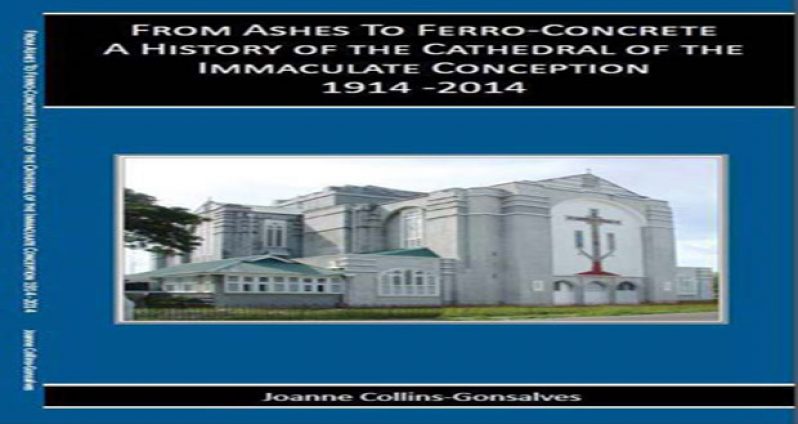From Ashes to Ferro-Concrete
– A History of the Cathedral of the Immaculate Conception 1914 – 2014
NOT every church building you enter into is consecrated sanctuary. There are certain criteria governing the consecration of a Catholic church. One of the churches in Guyana meeting those criteria is ‘The Cathedral of the Immaculate Conception’ also known as the Brickdam Cathedral. In the book, ‘From Ashes to Ferro-Concrete: A History of the Cathedral of the Immaculate Conception 1914 – 2014’, written by Joanne Collins-Gonsalves
and published by the Guyana Heritage Society, it is stated that ‘by 1960, the Cathedral…was finally free from debt and was consecrated on the 10th of October of that year’.
There are other reasons leading to the consecration of a Catholic church which will be unveiled in due course. Also stated in the book, completing the said paragraph (pages 36 & 37) from which the above quote was extracted is another fact, ‘[t]his consecration of the Cathedral of the Immaculate Conception was the conclusion of a long journey that began in 1914 when construction on the foundation of the Cathedral started’.
There were other journeys converging on the above mentioned journey. Some of the other journeys were even longer than the above like the centenary of the Cathedral (1914 – 2014), the arrival in May 1835 of Madeiran Immigrants who were mainly Catholic, and the birthing of Catholicism in Guyana which started since the 1770s. There was, however, one journey in the saga of the Cathedral which is not as long as the others and that is the birthing of this book. The research for this book started in 2004 to mark the Cathedral’s 90th anniversary and it was prompted by the late Past President of the Guyana Heritage Society, Mr Rizwan Khan.
The author, Joanne Collins-Gonsalves was mindful to juxtapose all those journeys in order that the lengthy history of the cathedral can be better appreciated logistically and spiritually. The logistical progress of the church is as inspiring as its spiritual progress.
In his Preface to the book, The Most Reverend Francis Deane Alleyne O.S.B., Bishop of Georgetown, Guyana, stated ‘what was celebrated by the faith community within the walls of the Cathedral spilled over into the celebration of life in homes and in the workplace’. This was referred to as ‘living stones’ – the body of people which made up the church of which was built of stone/s (Ferro-concrete).
The book is divided into three sections. Section 3 ‘Images of the Cathedral of the Immaculate Conception’ reproduces pictures of the destruction and reconstruction of the Cathedral and items saved from the 1913 fire. Section 2 ‘Surveys of the Official Documents and Newspaper Reports’ reproduces documents supporting the author’s dissertation. Section 1, ‘History of the Cathedral of the Immaculate Conception’ deals with three structures via the first building named ‘Christ Church’, the second building named, ‘Church of the Resurrection’ and the third building named the ‘Cathedral of the Immaculate Conception’. It is this third structure that is the focus of this book.
Those three sections are well supported with a ‘Chronological History’, a ‘Preface’ by the Bishop of Georgetown, an ‘Introduction’ by Professor Mary Noel Menezes, RSM, a ‘Bibliography’ and numerous photographs.
‘From Ashes to Ferro-Concrete: A History of the Cathedral of the Immaculate Conception 1914 – 2014’ is an integral part of the story of Guyana. The publication of this book by the Guyana Heritage Society is yet another manifestation of what can be achieved when people work together towards a good cause.
The cause or the motto of the Guyana Heritage Society is ‘To Protect and Preserve’ and its main objective is ‘to promote research on Guyanese heritage through lectures and publications and the preservation of indigenous skills related to the national heritage’. The Society has so far reprinted rare books like ‘Story of Georgetown’ by James Rodway, ‘Centenary History of British Guiana, 1831-1931’ by ARF Webber, and ‘The Twelve Views in the Interior of Guiana’ by Sir Robert Schomburgk. The Society has also published ‘History of Victoria Village’ by William N. Arno.
The Guyana Heritage Society can be contact via email: guyanaheritage@hotmail.com
(Persons wishing to respond to this author can telephone (592) 226-0065 or email: oraltradition2002@yahoo.com)
WHAT’S HAPPENING:
* The Guyana Annual Magazine 2014-2015 issue in now available at Guyenterprise Ltd., Lance Gibbs and Irving Streets, Tel # 226-9874
by Petamber Persaud



.jpg)








